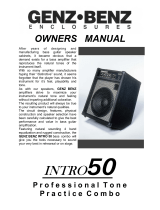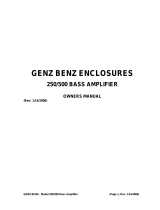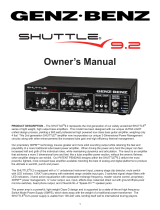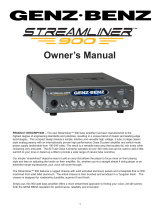Page is loading ...

Owner’s Manual
PRODUCT DESCRIPTION – GENZ BENZ, the leader in innovative lightweight separate bass ampliers and cabinets
now brings you the CONTOUR™500 bass combos; for those players who want a powerful and lighter weight one
piece amplier system. These combos deliver dramatic versatility from warm, tight, full bodied response to all out
aggressive overdrive and all points in between. For today’s bassist, the CONTOUR™500 delivers from the club to
concert stage.
The CONTOUR™500 is equipped with a ¼” instrument input, preamp stage clip detector, mute switch, extended range
variable input gain, ¼” tuner output, variable contour control, 3 band active equalization with sweepable midrange
frequency, aux input, master volume control, proprietary output limiter, balanced direct out with ground lift switch,
headphone output, and 2 Neutrik Speak-On™ speaker jacks.
The power amp is a powerful, lightweight Class D design and is supported by a state-of-the-art digital Switch Mode
Power Supply (SMPS), which does away with the weight of a traditional power transformer. The CONTOUR™500’s
power supply is usable from 100-240 volts, lending itself well to international players.

FRONT PANEL
DIRECT OUTPUT – An XLR balanced direct output is provided for connection to a PA system or directly into a recording
studio console. The Direct Out signal is mic level and pre eq. This output is fully protected against 48 volt phantom power
and may be used for driving microphone lines of up to 300 feet without problems.
LIFT / GROUND SWITCH – connects or lifts the Direct Out pin 1 ground to eliminate hum due to ground loops between the
bass amp and the mixing console.
PREAMP TUNER OUTPUT – The CONTOUR™500 is equipped with a fully isolated Tuner Output. This jack is located
after the front end scaling preamplier and is pre-eq. This output may also be used to drive a separate direct box or high-
impedance recording device. The Tuner Output remains active when the amplier is muted, allowing silent tuning on stage.
PREAMP INSTRUMENT INPUT – The CONTOUR™500 is equipped with a standard ¼” unbalanced input. The input
sensitivity range is from 200 mV to 1.6 volts. The input impedance is >700K ohms. The input stage contains a precision
high order active high pass lter (more effective and less intrusive than the more common 6 dB lters) and an “RFI” lter
(radio frequency interference) to eliminate unwanted noise. The input gain stage consists of a feedback type variable gain
circuit that provides wide range, continuously variable gain with minimal noise. The preamp contains a FET input amp
circuit based on our highly regarded GBE and Shuttle
®
series touring ampliers.
PREAMP MUTE SWITCH – With this mute switch, you can place the amplier (and Direct Output) in standby mode
between sets without having to change any of your amp settings. This feature can also be used for silent tuning since the
Tuner Out stays active when the mute is engaged.
PREAMP GAIN – This control sets the input sensitivity gain of the preamp to the output of your bass. The volume of
the signal is then controlled by the Preamp Volume control and also the Master Volume control. Note that overdriving
the input gain stage may be a desirable tonal characteristic of your playing style. This control, in conjunction with the
Preamp Volume and Master Volume controls, allows you to set the amount of input stage overdrive or clean tone your amp
produces. Dramatic changes in overdriven tone can be achieved with this control in the 3 o’clock to 5 o’clock positions.
It is recommended when using heavily distorted tones that you reduce the high frequency settings on the amp our cut the
tweeter level control on the cabinet.
“O/L” LED – This “Over-load” LED senses the operating status of the preamp and EQ stages. When this LED ashes,
overdriving of the EQ stage is occurring. Adjusting the Preamp Gain, Preamp Volume and EQ controls will affect the over-
load condition.
SETTING YOUR INPUT SIGNAL – Use the following guidelines to set your amplier input stage for the type of bass used
and your personal playing style. These guidelines are just a suggested starting point.
1) Set your instruments controls (volume and tone) where you normally prefer to run them.
2) Now set all controls on the CONTOUR™500 to 12 o’clock. It may be best to start with the Master Volume at 9 o’clock
and the Contour control in the at position.
3) For a clean tone and using a Passive bass your Gain and Preamp Volume settings may be set to similar positions. For
a clean tone using an Active bass your Gain setting should be set more towards the 9 o’clock position and the Preamp
Volume at noon to 2 o’clock positions.
4) For overdriven tones with Active or Passive basses your Gain setting will be set higher and the Preamp Volume set
lower. If driving the Gain Control towards maximum then the Preamp Volume should be set below the 10 o’clock position.
Set your Master Volume for your desired overall volume. We suggest experimenting with different settings for best results.
5) Now, turn your attention to the Contour control and EQ section, making the adjustments for your desired tone. Because
this is an active EQ network, any larger settings of cut or boost will affect the level of the preamp and the O/L light.
6) After setting your EQ it may be necessary to go back and adjust your preamp volume accordingly.
2

PREAMP VOLUME – This control sets the volume of the preamp after the Input and Gain stages but before the EQ,
Contour and Master Volume controls. Use this control in conjunction with the Gain Control.
CONTOUR – The Contour control alters the response of the preamp’s inherent voicing by decreasing midrange and
increasing bass and treble as the control is adjusted clockwise from the minimum or at position.
ACTIVE EQUALIZATION – The CONTOUR™500 contains an active 3 band equalizer with sweepable parametric
mid range frequency control. This equalizer, similar to those found on professional sound consoles, is a very useful tool.
The low frequency EQ section is an 80 Hz shelving curve with 15dB of cut or boost. The high frequency EQ section is a
4 KHz shelving curve with 15dB of cut or boost. The parametric sweepable-mid frequency section features 15 dB of cut
or boost with a bandwidth approximately 1 octave wide. The center frequency of this lter is continuously user adjustable
from 150 Hz to 2 KHz with a single control. This lter is typically (but not always) used to reduce or remove offending
frequencies in the instrument’s pick-up response, or boost response to achieve a particular voicing. Spend some time
experimenting so that the process becomes creative as well as corrective. Note that our active equalizers are very wide
response and a little bit can go a long way.
AUX INPUT – A 1/4” unbalanced line level Auxiliary Input is provided that sums directly to the main output bus, controlled
by the master volume control. This input is ideal for practicing with recorded tracks from a CD player, IPOD, or MP-3
player. This input is a tip-ring-sleeve type jack with built-in summing resistors that sum left and right signals when used with
a stereo cable. This input will also work with a mono tip-sleeve plug. Adjust the level of the playback source to balance
with the bass guitar’s volume.
MASTER VOLUME – The master volume control adjusts the overall volume of the amplier and the aux input. Typically,
best results are obtained when this control is operated between the 9:00 and 3:00 positions.
OUTPUT LIMITER – The CONTOUR™500 contains an internal power amplier “Soft Clip” limiter. This limiter allows
simulation of tube output stage saturation as the amplier nears it maximum power. The limiter is a compound multi stage
analog circuit, is quite graceful in nature, and is particularly musical sounding, even when driven hard. The output “LIMIT”
LED shows limiting action at the maximum power threshold and then indicates power amplier clipping as the power
amplier gradually transitions into gentle clipping.
POWER AMPLIFIER – The CONTOUR™500 uses a state of the art, class D power amplier design and a high frequency
switch-mode power supply (SMPS) to achieve unprecedented high performance and lightweight packaging. Switch-mode
power supplies convert the AC line directly to high voltage DC, then the precision PWM (pulse width modulation) inverter
creates a new AC power signal at a frequency more than 1000 times higher than the original wall frequency of 50/60Hz.
This new high voltage, high frequency power signal is then fed into a custom high frequency transformer that steps
the voltage down. A high frequency rectier and low ESR lter capacitors nish the process off by converting the high
frequency AC signal back to the DC voltages that the amplier’s internal circuitry uses. One advantage of this conversion
process is that the DC power supply rails are refreshed more than 1000 times more often than in traditional linear supplies,
thus reducing annoying hum in the audio signal. The high frequency switching is used to reduce the size and weight of
the magnetic and lter components while increasing the performance by recharging the power supply rails more often.
The class D amplier uses digital PWM techniques similar to those in more familiar digital to analog converters to reduce
the size and weight by a factor of 10 times that of a comparably rated conventional class AB amplier. Essentially, a class
D amplier converts the analog signal into a logic level PWM digital signal with an analog to digital converter then level
shifts this PWM signal up to a higher voltage and current and then reconstructs the analog signal by passing it through
what is essentially a power digital to analog converter. Additionally, we developed our own, proprietary limiting and signal
processing techniques to give a distinctly analog feel and sound to the class D platform. This system provides exceptional
performance for low frequency applications such as bass guitar.
HEADPHONES – A 1/4” TRS jack is provided for connection to headphones. A speaker load is not required. Do not
connect this output to anything but headphones. The internal speaker DOES NOT automatically shut off when using the
headphones. For silent practice use disconnecting the rear panel speaker connection is required.
MASTER SECTION STATUS INDICATORS -
• The blue “OPERATE” light indicates that the amplier is ON and the low voltage power supplies are active.
• The red “PROTECT” LED indicates that the amp is in “protect” mode. This LED may ash during power turn-on and turn-
off. This is normal. It will also illuminate during any internal fault condition. If this happens, turn the amp off and consult a
repair technician.
• The amber “LIMIT” LED indicates that the power amp is near its maximum power and has entered its soft clip/limit
mode. Under high output conditions this LED will light with the strongest pulses of the signal. Driving hard
beyond this point will cause the amplier to gradually begin to clip.
3

REAR PANEL
POWER INPUT – VOLTAGE SELECTOR SWITCH - The CONTOUR™500 utilizes a switch selectable universal power
supply that operates from 100V to 240 volts, 50 to 60 Hz for world wide use. Simply set the switch to the appropriate AC
mains voltage (BEFORE connecting to the power source), and utilize the proper IEC cord-set appropriate for the country
the product is being used.
For countries using 100V, 110V, 115V and 120V AC mains, select the 115V switch position on the Voltage Selector
switch.
For countries using 220V, 230V, and 240V AC mains, select the 230V switch position on the Voltage Selector switch.
There is no externally accessible AC mains (line) fuse. The internal fuse is integral to the SMPS power supply and is
not user serviceable. This fuse will not fail except under very unlikely fault conditions to the SMPS, and if this occurs a
qualied service technician is required to correct the problem.
SPEAKER OUTPUTS – The CONTOUR™500 provides two Neutrik Speak-On™ connectors (wired 1+/1-). The speaker
jacks are paralleled. The minimum speaker load is 4 ohms. Do not ground either the “+” or the “-” outputs. One jack is
used with the combo’s internal speaker and the other is available for use with an external (8 ohm minimum) speaker.
4

4 5
Specications
CTR500-115T COMBO -This model is the amplier with a single
15” low frequency driver and compression tweeter. It produces 300
watts into the 8 ohm combo conguration and 500 watts when used
with an additional 8 ohm extension cabinet. A tweeter level control
is provided. It will be necessary to use a Neutrik Speak-On™
connection when using an extension cabinet with this combo.
Dimensions: 27”H X 18”W X 16”D
Weight: 48 LBS
CTR500-210T COMBO -This model is the amplier with 2 x 10”
low frequency drivers and compression tweeter. It produces 300
watts into the 8 ohm combo conguration and 500 watts when used
with an additional 8 ohm extension cabinet. A tweeter level control
is provided. It will be necessary to use a Neutrik Speak-On™
connection when using an extension cabinet with this combo.
Dimensions: 27”H X 18”W X 16”D
Weight: 52 LBS
CTR500-EXT115 - Matching extension cabinets are offered for
stacking under the CONTOUR™500 combos. This model is an
identical cabinet conguration of the 1 x 15” combo. Speak-On™ and
1/4” connectors along with a tweeter level control are provided on the
rear panel.
Dimensions: 24½”H X 18”W X 16”D
Weight: 40 LBS
CTR500-EXT210 - Matching extension cabinets are offered for
stacking under the CONTOUR™500 combos. This model is an
identical cabinet conguration of the 2 x 10” combo. Speak-On™
and 1/4” connectors along with a tweeter level control are provided
on the rear panel.
Dimensions: 24½”H X 18”W X 16”D
Weight: 42 LBS

6
BLOCK DIAGRAM
SAFE OPERATING REQUIREMENTS:
• Never set an amplier on anything that will tip over or collapse under its weight.
• Provide a minimum distance of 25.4 mm (1 inch) around all sides of the amplier for sufcient ventilation.
The ventilation should not be impeded by covering the amplier’s vent openings with items such as newspapers,
tablecloths, curtains, etc.
• No naked ame sources, such as lighted candles, should be placed on the amplier.
• This amplier should not be exposed to dripping or splashing and no objects lled with liquids, such as vases or
drinks, should be placed on this product.
• The CONTOUR™500 amplier should always be connected to a mains socket outlet (power receptacle) with a
protective earth (ground) connection at all times.
• The ampliers mains plug (power plug) is considered the disconnect device and the connection must remain
accessible at all times.
• This amplier is capable of producing sound pressure levels that may cause hearing loss.
• There are no user serviceable parts and hazardous operating voltages are present inside this unit. Always consult a
qualied repair facility for service.
WARNING!
• The use and operation of this device constitutes an agreement of full release of any and all liability connected with its
use. Only persons familiar with the operation of high-powered professional audio equipment should attempt to operate
this device.
• In addition, by use of this device the user agrees to hold Genz Benz and its designers, sales agents and all other
afliates and related parties harmless in the event of any accident, injury, damage, or loss resulting from such use.
• Manufacturer’s sole responsibility is to provide a warranty on the specied performance of the product under normal
operating conditions for a period of 3 years.

7
Declaration of Conformity
(89/336 EEC-EMC Directive)
Manufacturer’s Name: Genz Benz, a division of KMC Music Corporation
Manufacturer’s Address: 7811 East Pierce Street
Scottsdale, AZ 85257, U.S.A.
Product Type: Audio Amplier
Model Number: CONTOUR™500 (all versions)
Operating Power Condition: 100/115/230/240V, 50/60 Hz
Effective Date: 1-01-2012
Conforms to the Following Standards: [X] EN 55013: 2001 + A1: 2003
[X] EN 55020: 2002 + A1: 2003
[X] EN 60065: 2001 + A1, A11, A12, A2
[X] IEC 61000-3.3: 1994 + A1: 2001
[X] IEC 61000-4.2
[X] IEC 61000-4.3
[X] IEC 61000-4.4
[X] FCC 15.107 and 15.109
[X] RoHS Directive 2002/95/EC
[X] WEEE Directive 2002/96/EC
[X] CE Mark LV Directive 73/23 EEC
A KMC Music Corporation, Bloomeld, CT
7811 E. Pierce St. Scottsdale, AZ 85257
Ph: 480-941-0705 Fax: 480-946-2412
www.genzbenz.com
WARRANTY:
• Genz Benz warrants the model CONTOUR™500 to be free from defects in materials and workmanship for a period of
3 years from the date of purchase, when purchased from an authorized Genz Benz dealer.
• This warranty does not cover normal wear and tear incurred from the normally designed use of the product.
• This warranty is effective only if a copy of the original sales receipt is presented at the time of warranty service.
• This limited warranty is completely transferable to any subsequent buyer as long as the original sales receipt is also
transferred to such subsequent buyer.
• All warranty service must be performed by a Genz Benz authorized service center.
• Before returning any unit for service, a returned merchandise authorization number (RMA#) must be obtained by
calling 480-941-0705.
• This warranty is valid in the US & Canada only. For all products sold outside the USA, warranty is handled through our
international distributor for each country. For more information visit our website www.GENZBENZ.com
REV 1
/








